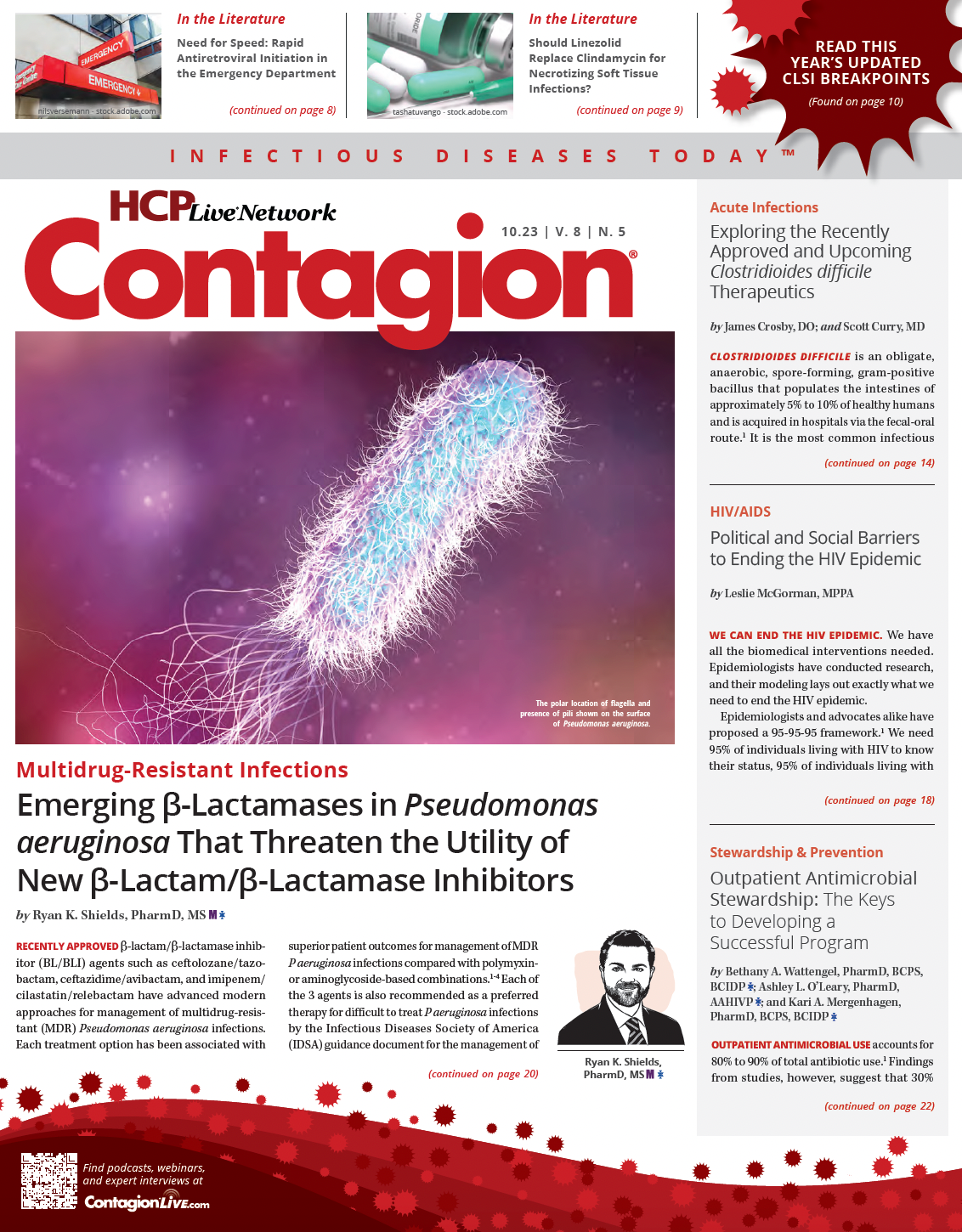Testing for Viral Respiratory Illnesses: Best Practices, Types of Tests, Advantages and Drawbacks, and Patient/Provider Education
This discussion revolves around diagnostics for viruses and best practices and challenges.

Testing for influenza, COVID-19, and respiratory syncytial virus (RSV) is important for individuals at high risk for these diseases, and broadening access to at-home testing and treatment could improve infection control in the community and minimize unnecessary use of health care resources, according to panelists who participated in a recent Contagion Peer Exchange panel moderated by Tina Tan, MD. The panelists also discussed factors to consider when deciding whether to test patients for viral respiratory illnesses, advantages and drawbacks of different testing platforms, and education of patients and practitioners about testing and treatment.
TESTING FOR VIRAL RESPIRATORY INFECTIONS
Having a low threshold for testing of viral respiratory infections enables adequate delivery of treatment, Wendy Wright, DNP, ANP-BC, FNP-BC, FAANP, FAAN, FNAP, said. Although patients have often received multiple COVID-19 tests by the time they present to the clinic, many of them have not received tests for influenza or RSV.
“If you’ve got an upper respiratory infection, you’ve got one [of these illnesses] until proven otherwise,” Wright said. “Earlier [testing] is better so that we can get them treated, particularly our patients [at] high risk.”
For asymptomatic individuals who were knowingly exposed to a virus, Kevin Michael Reiter, MD, PA, does not typically test them if resources are limited (particularly influenza tests). However, he is more willing to test asymptomatic patients exposed to COVID-19 with a high-quality molecular test if resources are adequate because of the considerable presymptomatic spread of that virus.
The CDC recommends obtaining respiratory specimens for influenza and SARS-CoV-2 testing for patients with symptoms of acute respiratory illness who require hospital admission during periods when both viruses are circulating.1 According to Priya Nori, MD, testing for COVID- 19, influenza, and RSV during periods of heavy circulation in the community has been helpful for triaging patients at hospital admission and has implications for infection control and treatment. However, she noted that current availability of testing materials and antiviral therapy is important to consider when deciding which patients to test, and she generally recommends testing only if the results would affect patient care. For patients who attain a negative result on rapid antigen tests and for whom the test results would influence management, Reiter performs a rapid molecular assay for influenza followed by a COVID-19 polymerase chain reaction (PCR) test to confirm the results. Tan also noted that the test accuracy may be influenced by the patient’s age; for example, the antigen test for RSV is more accurate in young children than in older children, adolescents, and adults.
MECHANISMS OF ACTION FOR TESTING OF RESPIRATORY INFECTIONS
The 2 main types of diagnostic tests used for viral respiratory infections are antigen tests and molecular tests. Antigen tests, which detect a specific protein (antigen) from the virus, are also known as rapid tests and are used for at-home testing or self-testing (although they are also used in clinical settings).2 Molecular tests, which include reverse transcriptase polymerase chain reaction (RT-PCR) tests and other nucleic acid amplification tests (NAATs), amplify the RNA, which enables detection of a very small amount of viral RNA and decreases the likelihood of a false positive result.3 Samples for molecular tests can be collected at home or a testing site but must be processed in a laboratory, whereas results from rapid antigen tests are available within minutes and do not require laboratory processing.2
Jacinda C. Abdul-Mutakabbir, PharmD, MPH, noted that different types of NAATs take distinct approaches to detecting the presence of a virus. RT-PCR tests convert the viral RNA into complementary DNA, which is subsequently amplified using thermal cycling, whereas transcription-mediated amplification tests isothermally amplify ribosomal RNA via reverse transcription and synthesis of RNA transcripts via RNA polymerase.4 “Even if you have been exposed and aren’t showing symptoms—you’re asymptomatic—you’re likely to get that [positive] PCR test [result],” Abdul-Mutakabbir said.
Two types of antibody tests—the qualitative nucleocapsid antibody test and a quantitative spike protein antibody test—are available for COVID-19 and can detect prior exposure or vaccination, but they are not the appropriate test to detect a current infection, Abdul-Mutakabbir said. Additionally, the antibody tests are unable to determine whether the presence of antibodies is due to prior infection or vaccination against COVID-19.
Abdul-Mutakabbir noted that many individuals are using the combined test for influenza and COVID-19 recently approved by the US Food and Drug Administration5 to determine whether their symptoms are caused by 1 of those 2 viruses, although she added that follow-up PCR testing may be needed to confirm which infection is present and to guide management.
ADVANTAGES AND LIMITATIONS OF AVAILABLE TESTING MODALITIES FOR RESPIRATORY INFECTIONS
Although much progress was made with at-home testing for COVID-19 during the COVID-19 pandemic, developing and improving the technology to test for the 3 major respiratory viruses— influenza, RSV, and COVID-19—should remain a high priority moving forward, Nori said. “Imagine the implications if you have a positive test [result] and then you have a series of instructions on how to isolate, how to supportively care for yourself, and how to get those treatments without stopping in urgent care, without stopping in the [emergency department], and without utilizing all those health care resources,” she said. “Think of the implications for the economy, the patient, and infection control. You don’t want these human beings [with infection] circulating around society, taking the bus, sitting in the waiting rooms of these offices. That’s where we need to be in the next couple years.”
Rapid diagnostic testing is also important for initiating treatment within the optimal treatment windows, ie, within 48 hours of diagnosis for influenza and 5 days of diagnosis for COVID-19, Reiter said. He added that the ability to accomplish this with a virtual visit and at-home testing would be a major step forward for infection prevention in the community.
Reiter noted that widespread testing for respiratory viruses could also support antibiotic stewardship programs such as the one initiated at Northwell Health-GoHealth Urgent Care in 2019.6 This program provides feedback to providers about their antibiotic prescribing practices
relative to their peers and about situations in which they are inappropriately prescribing antibiotics, especially for acute bronchitis, nonstreptococcal pharyngitis, and viral rhinosinusitis.6
“If we know for sure that these are viral infections because we have an otherwise healthy person or a compromised individual who’s presenting with acute bronchitis and we test and know it’s coming from RSV, we’re more reassured. We can tell them that 80%, 90% of these infections are viral, but when they see the result…we can say, ‘This is RSV. This is a viral infection. Here’s the result.’ That carries more weight,” Reiter said.
PATIENT AND PROVIDER EDUCATION FOR RESPIRATORY INFECTION TESTING MODALITIES
According to Wright, patients should be tested early, particularly when they are symptomatic, and she recommends RT-PCR testing (if resources allow) for asymptomatic individuals who have knowingly been exposed to one of the testable viruses. Although the accuracy of antigen testing is not optimal, Wright said it can help guide practitioners and provide reassurance to patients.
Although the CDC’s list of individuals who qualify for antiviral therapy can be used as a guide for determining who should receive the treatment, Wright noted that practitioners should also consider whether the patient is living with household members who are at high risk for severe illness.
“We often ration care when we don’t have options available and we can’t get these medications, but we don’t always know who these people live with,” Wright said. “By not offering these tests and these treatments, we may be putting people at risk whom we don’t know exist in their homes.”
Abdul-Mutakabbir added that pharmacists can also educate members of the community about strategies for interpretation of at-home tests, self-management after attaining a positive result, and serial retesting based on the results of prior tests. Although quarantining is ideal, Abdul-Mutakabbir noted that this may not be possible in some cases and advocated for wearing masks around other household members if complete isolation is not possible. Additionally, pharmacists can help patients identify when supportive care medications are adequate and teach them signs that indicate going to the hospital is necessary. Abdul-Mutakabbir noted that the American Pharmacists Association has tools to assist pharmacists in conversations with individuals about testing and vaccinations.
Nori concluded that although shortages of antiviral medications and testing materials occur periodically, many of the lessons learned over the past 2 to 3 years are likely to help guide practitioners through future testing and treatment challenges. “We’ve had periodic shortages of things [but also] well-meaning individuals and people in the business of providing care for patients,” she said. “We always managed to find a way."
References
1.Testing guidance for clinicians when SARS-CoV-2 and influenza viruses are co-circulating. Centers for Disease Control and Prevention. Updated February 9, 2022. Accessed August 20, 2023. https://www.cdc.gov/flu/professionals/diagnosis/testing-guidance-for-clinicians.htm
2.COVID-19 test basics. US Food and Drug Administration. Updated January 4, 2023. Accessed August 24, 2023. https://www.fda.gov/consumers/consumer-updates/covid-19-test-basics
3.Nucleic acid amplification tests (NAATs). Centers for Disease Control and Prevention. Updated May 12, 2023. Accessed August 24, 2023. https://www.cdc.gov/coronavirus/2019-ncov/lab/naats.html
4.Wernecke M, Mullen C. Molecular biology in microbiological analysis. In: Batt CA, Tortorello ML, eds. Encyclopedia of Food Microbiology. 2nd ed. Elsevier; 2014:808-814. Accessed August 20, 2023. https://doi.org/10.1016/B978-0-12-384730-0.00225-1
5.FDA authorizes first over-the-counter at-home test to detect both influenza and COVID-19 viruses. News release. February 23, 2023. Updated March 1, 2023. Accessed August 24, 2023. https://www.fda.gov/news-events/press-announcements/fda-authorizes-first-over-counter-home-test-detect-both-influenza-and-covid-19-viruses
6.Northwell Health-GoHealth Urgent Care earns HANYS 2021 Pinnacle Award for antibiotic stewardship program. GoHealth Urgent Care. Accessed August 24, 2023. https://www.gohealthuc.com/news/northwell-health-gohealth-urgent-care-earns-hanys-2021

2 Commerce Drive
Cranbury, NJ 08512
All rights reserved.
